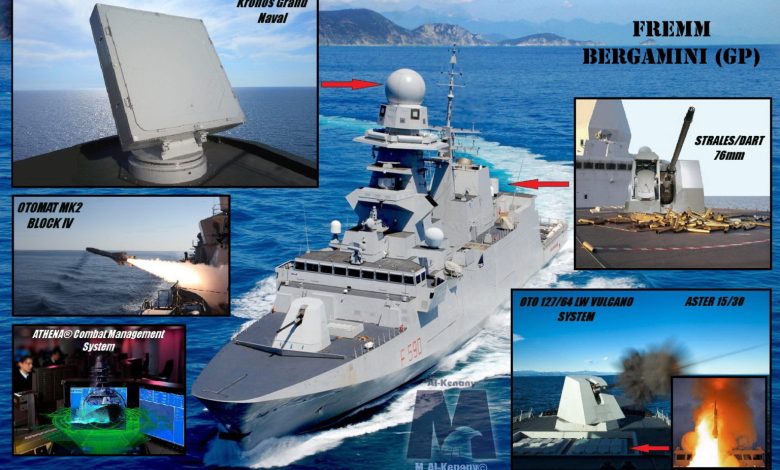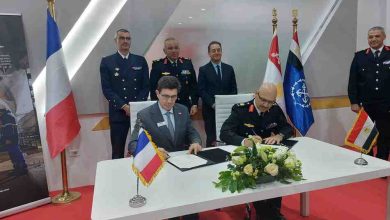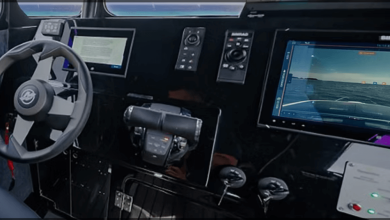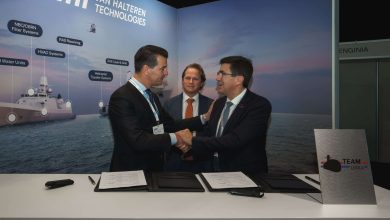
Discover the Majesty of Egypt’s FREMM Bergamini
FREMM is initially a collaborative French-Italian initiative between Naval Group and Fincantieri aimed at constructing a robust multi-mission frigate, hence the name “FREMM”, an abbreviation for “European multi-mission frigate” in French “Frégate Européenne Multi-Mission” and in Italian “Fregata Europea Multi-Missione”. This provides an overview of the FREMM Bergamini recently commissioned by Egypt.
The French variant of this frigate is termed Aquitaine, which comes in two models; the FR‑ASW anti-submarine type and the FR-AAW air defense type. Egypt possesses 1 unit of the FR‑ASW anti-submarine model, while Morocco has also acquired 1 of the same type.
The French variant has a displacement of 6000 tons, measures 142 meters in length, has a draught of 7.6 meters, achieves a maximum speed of 50 km/h, and a range of 11,000 km, accommodating up to 145 personnel.
The Italian variant is named Bergamini and offers two configurations; an IT-ASW anti-submarine type, and an IT-GP general-purpose type with enhanced air defense and surface warfare capabilities.
The Italian variant’s displacement is 6,700 tons, its length reaches 144.6 meters, with a draught of 8.7 meters, a top speed of 56 km/h, a range of 12,600 km, and capable of housing up to 200 individuals.
Egypt is set to receive 2 of the general-purpose variant and intends to procure an additional 4 units in the future, the specifications of which remain undisclosed.
The US Navy has opted for the Italian design for its upcoming FFG(X) program, which aims to construct twenty guided-missile frigates.
Key Features of the General-Purpose Variant for the Egyptian Navy:
- The “KRONOS Grand Naval” radar, an advanced multifunctional radar utilizing cutting-edge Active Electronically Scanned Array (AESA) technology, serves as the primary radar for the Principal Anti-Air Missile System (PAAMS). The KRONOS Grand Naval features include enhanced self-defense, aerial and surface monitoring, and simultaneous tracking of multiple targets, volumetric search, and multiple missile guidance. It boasts a range of 300 km, the capacity to track 300 targets concurrently, and the capability to guide long-range Aster-30 air defense missiles. It can execute multiple target trackings to support 16 Aster missiles during intense missile assaults. This radar is the most powerful in the FREMM lineup, surpassing the radar used in the French variant.
- This radar offers exceptional early warning capabilities and situational awareness necessary to manage and coordinate various aerial and maritime operations, providing improved protection and support during naval and aviation movements in scenarios devoid of early warning and aerial control aircraft.
- The sophisticated Athena Combat Management System, which integrates all necessary functions for monitoring and management, tactical battle image processing, navigation assistance, threat assessment, weaponry missions, and systems management, mission strategizing, multiple tactical data links, and training. It achieves this through its control over all radars, electro-optical/thermal sensors, sonar, armaments, and combat mechanisms, facilitating operation management, command oversight, and coordination with other naval and allied combat platforms.
- A superior air defense capability conferred by 16 Vertical Launch System (VLS) cells armed with the following missiles:
- Aster-15 medium-range missiles with a range of 30 km designed to counter all aerial threats including air-launched missiles and cruise missiles, including those at supersonic speeds (equipped in the Egyptian variant).
- Aster-30 long-range missiles with an impressive range exceeding 120 km, capable of addressing all aerial threats and intercepting ballistic missiles launched from 1500 km away.
- The frigate is additionally equipped with a 76 mm rear gun, part of the STRALES / DART system, which includes a cannon as well as a tracking and monitoring system, supplemented with DART radio wave guided weapons that target aerial challenges such as anti-ship missiles and also marine threats like fast-moving crafts, with a range exceeding 8 km and an initial velocity of 3960 km/h.
- Improved combat capability against surface vessels is provided by the 127 mm OTO 127/64 front main gun, featuring a firing rate of 32 rounds per minute and a firing range exceeding 30 km. This range can be extended using “Vulcano” ammunition, with unguided variants reaching up to 60 km and directed munitions exceeding 80 km and reaching up to 100 km.
The primary surface-to-surface combat tasks are executed with 8 Otomat MK2 Block IV mobile anti-ship missiles capable of engaging land targets near coastal areas, boasting a range of 200 km and equipped with an inertial navigation system, satellite guidance, and active radar. This missile system features data links for trajectory adjustment and control. The Otomat is renowned for integrating the superior range of precision with sea-skimming flight (estimated at 1-2 meters above sea level), along with a heavy warhead matching the American Harpoon (210 kJ compared to 221 kJ for Harpoon and 165 kJ for Exocet) and attaining the highest subsonic speed among anti-ship cruise missiles in its class (1100 km/h). The frigate is also outfitted with two 25mm remote-controlled cannons to counter swiftly approaching threats.
- The two frigates earmarked for the Egyptian Navy, previously assigned to the Italian Navy (identification numbers 9 and 10 within the Italian Frim frigate fleet; the Italian Navy currently operates 8 frigates), are distinguished by their enhanced system for launching deceptive decoys to mislead anti-ship missiles. The launcher accommodates 20 decoys instead of the previous 15 and is designed to engage not only missiles but also torpedoes launched from submarines, offering integrated defense against air, surface, and underwater threats.
- These two frigates feature an updated Damage Control System and a new radar utilizing technology that minimizes detection risk. The SPS-732 model replaces the prior RAN30X/I RASS radar, proving efficient in air and maritime surveillance, particularly for small-sized targets, allowing it to track missiles on a trajectory close to the sea surface. Lastly, a new array of IFF Sensors substantially enhances effectiveness compared to its predecessor.
- Although the general-purpose variant is not tailored for anti-submarine warfare due to the absence of a Towed Variable Depth Sonar (VDS), it is equipped with a forward low-frequency sonar under the bow, a Thales UMS 4110 CL that provides long-range detection capabilities in the surrounding environment, enabling countermeasures against submarines, and directs 324 mm MU90 torpedoes launched from two triple launchers, located on either side of the frigate. Additionally, it includes sonar designated for marine mine detection.
FREMM Bergamini
Considered to be one of the premier platforms for delivering primary air defense and protection operations for the Mistral carriers alongside forthcoming MEKO frigates and Gowind corvettes.
FREMM Bergamini serves as a command and control hub, equipped for early warning and maritime management, adept at overseeing all operations while connecting with a variety of air, sea, and land systems. It enhances the operational effectiveness of combat missions against surface vessels.
The FREMM Bergamini, with its advanced air defense capabilities and the French Frem Aquitaine (ENS Tahya Misr) along with Gowind corvettes boasting enhanced anti-submarine features and prospective MEKO frigates, collectively represent a formidable surface force that is exclusive to NATO navies. When integrated with Air Force capabilities, particularly the Rafale and Falcon (and potentially the Typhoon if an agreement is finalized), this establishes an unmatched air-to-sea assault and deterrence force in the eastern Mediterranean, only accessible to NATO armed forces.

Translated from Arabic to English by the «New Defence Order. Strategy» journal







